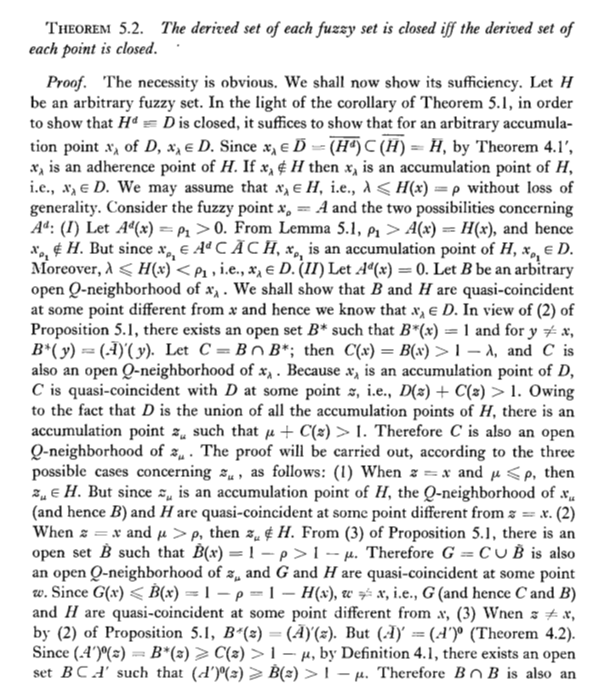Question
Greetings, please explain the theorem and give your PROOF with steps so I may understand and follow your work. I cannot follow the proof given.
Greetings, please explain the theorem and give your PROOF with steps so I may understand and follow your work. I cannot follow the proof given. Thank you.

open Q-neighborhood, which is quasi-coincident with H at some point w. Since B C 4, B(x)
THEOREM 5.2. The derived set of each fuzzy set is closed iff the derived set of each point is closed. Proof. The necessity is obvious. We shall now show its sufficiency. Let H be an arbitrary fuzzy set. In the light of the corollary of Theorem 5.1, in order to show that H' =D is closed, it suffices to show that for an arbitrary accumula- tion point x; of D, x's D. Since x, E D = (HU)C(H) = H, by Theorem 4.1', X, is an adherence point of H. If x, H then x, is an accumulation point of H, i.e., d'y e D. We may assume that x; E H, i.e., ^p, then H. From (3) of Proposition 5.1, there is an open set such that B(x) = 1 -p>I-. Therefore G =CU is also an open Q-neighborhood of %, and G and H are quasi-coincident at some point w. Since G(x) C(x) > 1 - u, by Definition 4.1, there exists an open set BC ' such that (1)() > B(x) > I - . Therefore Bn B is also an THEOREM 5.2. The derived set of each fuzzy set is closed iff the derived set of each point is closed. Proof. The necessity is obvious. We shall now show its sufficiency. Let H be an arbitrary fuzzy set. In the light of the corollary of Theorem 5.1, in order to show that H' =D is closed, it suffices to show that for an arbitrary accumula- tion point x; of D, x's D. Since x, E D = (HU)C(H) = H, by Theorem 4.1', X, is an adherence point of H. If x, H then x, is an accumulation point of H, i.e., d'y e D. We may assume that x; E H, i.e., ^ p, then H. From (3) of Proposition 5.1, there is an open set such that B(x) = 1 -p>I-. Therefore G =CU is also an open Q-neighborhood of %, and G and H are quasi-coincident at some point w. Since G(x) C(x) > 1 - u, by Definition 4.1, there exists an open set BC ' such that (1)() > B(x) > I - . Therefore Bn B is also an
Step by Step Solution
There are 3 Steps involved in it
Step: 1

Get Instant Access to Expert-Tailored Solutions
See step-by-step solutions with expert insights and AI powered tools for academic success
Step: 2

Step: 3

Ace Your Homework with AI
Get the answers you need in no time with our AI-driven, step-by-step assistance
Get Started


